
Catalonia is an autonomous community of Spain, designated as a nationality by its Statute of Autonomy. Most of its territory lies on the northeast of the Iberian Peninsula, to the south of the Pyrenees mountain range. Catalonia is administratively divided into four provinces or eight regions, which are in turn divided into 42 comarques. The capital and largest city, Barcelona, is the second-most populated municipality in Spain and the fifth-most populous urban area in the European Union.

Catalan cuisine is the cuisine from Catalonia. It may also refer to the shared cuisine of Northern Catalonia and Andorra, the second of which has a similar cuisine to that of the neighbouring Alt Urgell and Cerdanya comarques and which is often referred to as "Catalan mountain cuisine". It is considered a part of western Mediterranean cuisine.

Benabarre, in Ribagorçan and Aragonese: Benavarri is a town and municipality in the Aragonese comarca of Ribagorza, in the province of Huesca, Spain.

Palau de la Música Catalana is a concert hall in Barcelona, Catalonia, Spain. Designed in the Catalan modernista style by the architect Lluís Domènech i Montaner, it was built between 1905 and 1908 for Orfeó Català, a choral society founded in 1891 that was a leading force in the Catalan cultural movement that came to be known as the Renaixença. It was inaugurated on 9 February 1908.
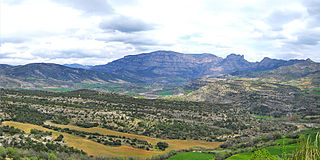
Ribagorça or Ribagorza is a historical and natural region of Aragon and Catalonia. Located in the Pre-Pyrenees and Pyrenees area, most of its territory is mountainous. The region has been steadily losing population since mid 20th century.

"Els Segadors" is the official national anthem of Catalonia, nationality and autonomous community of Spain.
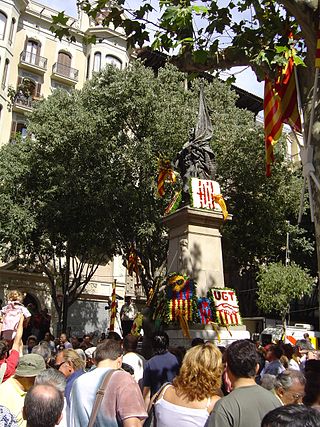
The National Day of Catalonia is a day-long festival in Catalonia and one of its official national symbols, celebrated annually on 11 September. It commemorates the fall of Barcelona during the War of the Spanish Succession in 1714 and the subsequent loss of Catalan institutions and laws.
Fum, Fum, Fum is a traditional Catalan Christmas carol. It was first documented by the folklorist Joaquim Pecanins in 1904, who had heard the song at the Christmas Eve midnight mass in Prats de Lluçanès. However, the song's origins stretch back to the 16th or 17th century, according to folklorist Joan Amades.
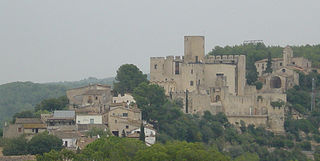
Castellet i la Gornal is a municipality in the comarca of the Alt Penedès in Catalonia, Spain. It is situated in the valley of the Foix river at the point where it crosses the Coastal Range. The river is dammed to form the Foix reservoir. The ajuntament is in La Gornal. The municipality is served by the N-340 road, and by a local road to Vilanova i la Geltrú.

A botijo, also called búcaro in Spanish, càntir in Catalan, canabarro in Galician and txongil in Basque, is a traditional porous clay container designed to contain water. The botijo, or water jar, is a typical element of culture in many parts of Spain and may vary in shape and color. Although the botijo can, exceptionally, also be found in glass, metal or even plastic, it is usually and traditionally made of clay, due to the properties of this material, such that, once the botijo is filled, it cools the water that it contains, acting as an evaporative cooler.
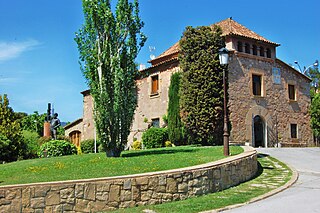
A masia in Catalan is a type of rural construction common to the east of Spain: Catalonia, Valencian Community, Aragon, Languedoc and Provence. The estate in which the masia is located is called a mas. They are often large but isolated structures, nearly always associated with a family farming or livestock operation.
"El cant dels ocells" is a traditional Catalan Christmas song and lullaby. It tells of nature's joy at learning of the birth of Jesus Christ in a stable in Bethlehem. The song was made famous outside Catalonia by Pau Casals' instrumental version on the cello. After his exile in 1939, he would begin each of his concerts by playing this song. For this reason, it is often considered a symbol of Catalonia.

Claudi Lorenzale i Sugrañes was a Spanish painter, associated with the German Nazarene movement and local efforts to recover the history of the Catalan region.
Evil customs were specific medieval feudal customs, generally levies, which peasants were subjected to by their feudal lords in the Crown of Aragon and other European countries. These obligations are related to the Ius Maletractandi, a right approved by the Catalan Court of 1358, which empowered the feudal lords to treat their people in ways later considered unjust.
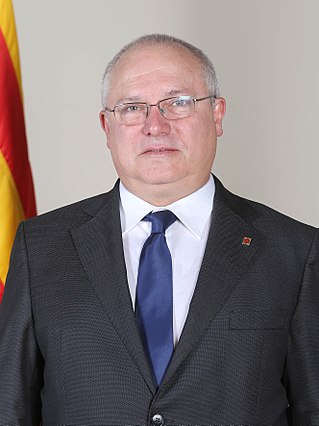
Lluís Puig i Gordi is an art director, dancer, musician, folklorist and Spanish politician from Catalonia. He was Minister of Culture of Catalonia, the department in charge of the libraries, language and heritage preservation, historical commemorations... He succeeded Santi Vila on 5 July 2017.

The Catalan Republic was a state proclaimed in 1931 by Francesc Macià as the "Catalan Republic within the Iberian Federation", in the context of the proclamation of the Second Spanish Republic. It was proclaimed on 14 April 1931, and superseded three days later, on 17 April, by the Generalitat de Catalunya, the Catalan institution of self-government within the Spanish Republic.

Josep Anselm Clavé i Camps was a Spanish politician, composer and writer, founder of the choral movement in Catalonia and a promoter of the associative movement.
The Internal Security Board of Catalonia was a body created in September 1936 as a result of the pact reached by the republican political forces on the one hand and the CNT-FAI on the other. The Generalitat de Catalunya and all democratic parties reached this agreement with the CNT-FAI to try to pacify public safety, severely altered since the July 1936 military coup, under the auspices of the anarcho-syndicalist organization. This pact involved the dissolution of the Central Committee of Antifascist Militias, replaced in part by the Junta. The militant anarchist Aurelio Fernández Sánchez was appointed general secretary, while in one way or another Rafael Vidiella (PSOE) and Joaquim Olaso i Piera (PSUC) were also present, as well as Tomàs Fàbregas Valls (ACR).

Núria Feliu i Mestres was a Spanish Catalan singer and actress, a singular figure of the Nova Cançó movement.
Josep Espar i Ticó was a Catalan businessman, politician and cultural activist.
















